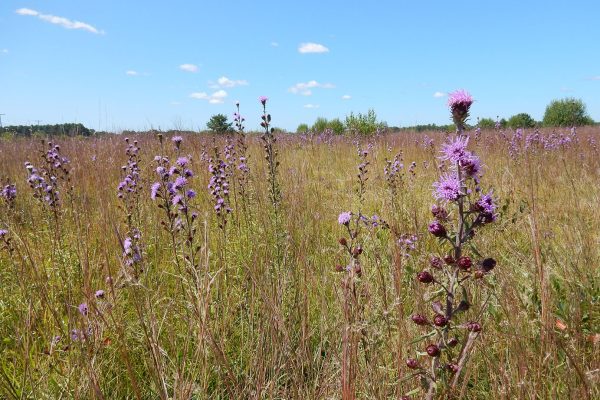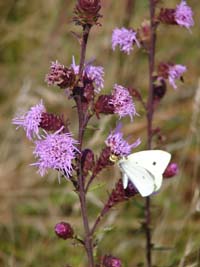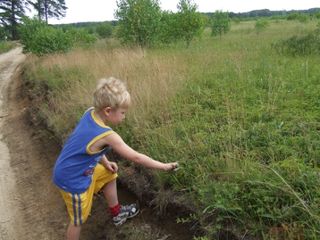Looking for a beautiful natural area to bring the family to this summer? Maine’s beaches are wonderful, and our mountains are spectacular. But how about some place you might not think of, some place unique and incredibly special, some place that also is a good reminder of why the Land for Maine’s Future program is such a treasure for all who love Maine?

Northern blazing star in bloom on Kennebunk Plains, by Allison Wells
In July, I visited one of my favorite Maine places, the Kennebunk Plains. This place is special to me for many reasons. For one, I have a long history with it. In the mid-80s, my husband spent many summers there first as a research assistant then as a Cornell Ph.D. candidate. When I wasn’t writing my own master’s thesis, chances were good that I was traipsing around the Plains, as it’s often called, helping out as a field assistant—spot-mapping, conducting point counts, and otherwise living and breathing the plants and animals of the Kennebunk Plains. Which brings me to another reason this place is so special.
The plants and animals that call it home. The Kennebunk Plains is a rare, and the largest, sand plain grassland in New England. This 3,200-acre area spans Route 99 and McGuire Road in Kennebunk and is host to rare flowers like the white-topped aster, upright bindweed, and, this time of year, the world’s largest stand of the extremely rare northern blazing star, which turns the vast acres purple. Along with these rare flowers come an abundance of butterflies and other fascinating insects—the beautiful metallic green tiger beetles and steely robber flies, and crickets and grasshoppers galore—and with those come birds, birds, birds.
Being a lifelong birder, it’s the birds that I love best about the Kennebunk Plains. Although most have stopped singing by now in order to feed and raise their broods, you may still hear the “wolf whistle” of the Upland Sandpiper, a bird on Maine’s endangered species list, and if you’re lucky, maybe the “chip-chip bzzzzz” of the state-endangered Grasshopper Sparrow. Prairie Warbler, Boblink, Vesper and Savannah sparrows—these are just a few of the other species you can find here, and that doesn’t include rarities we’ve found there over the years, like Sandhill Crane (long before they began breeding in Maine), Western Meadowlark, Golden Eagle, Scissor-tailed Flycatcher (at the adjoining Wells Barrens), and even a bird that typically spends its entire life at sea, Pomarine Jaeger! This year, a pair of Clay-colored Sparrows was confirmed breeding there—a bird that had for many years been a vagrant to Maine. The Plains is also one of few places where you can with some certainly find Whip-poor-wills singing in the evenings.
 These highlights alone are worth a visit, but the list of the Kennebunk Plains’ special qualities goes on and on. Winding through the acres is a maze of dirt roads that make the area a nice place to walk, jog, ride bikes, or horseback ride (and in winter, bring your cross-country skies!)
These highlights alone are worth a visit, but the list of the Kennebunk Plains’ special qualities goes on and on. Winding through the acres is a maze of dirt roads that make the area a nice place to walk, jog, ride bikes, or horseback ride (and in winter, bring your cross-country skies!)
If you decide to go this time of year, bring your binoculars, but also bring a few bowls with you, because the fields are sweet with delicious Maine blueberries. In fact, back when we were doing our research there, the Plains was owned and managed by a commercial blueberry company. Which brings me to perhaps the most important reason why this place is so special.
 It could have been a golf course. Or yet another housing development. But it’s not. There was talk back then that the company was fielding offers from developers who saw this place as easy land to clear and develop, blind to the magnificent plants and animals found here. Thankfully, others valued what make it so special—the Kennebunk and Great Works land trusts; the Kennebunk, Kennebunkport, and Wells water districts, Town of Kennebunk, and other groups. They saw the tremendous ecological value of the Kennebunk Plains and stepped in. Thanks to their determination, the Kennebunk Plains was among the first projects to receive Land for Maine’s Future funds, the popular matching funds program that provides funding for lands important for the public good. The Natural Resources Council of Maine has, will continue to work, very hard for funding for this important program. The Kennebunk Plain is one example of why.
It could have been a golf course. Or yet another housing development. But it’s not. There was talk back then that the company was fielding offers from developers who saw this place as easy land to clear and develop, blind to the magnificent plants and animals found here. Thankfully, others valued what make it so special—the Kennebunk and Great Works land trusts; the Kennebunk, Kennebunkport, and Wells water districts, Town of Kennebunk, and other groups. They saw the tremendous ecological value of the Kennebunk Plains and stepped in. Thanks to their determination, the Kennebunk Plains was among the first projects to receive Land for Maine’s Future funds, the popular matching funds program that provides funding for lands important for the public good. The Natural Resources Council of Maine has, will continue to work, very hard for funding for this important program. The Kennebunk Plain is one example of why.
A friend of mine who lives in Kennebunk (and has been updating her Facebook page regularly with posts about her berry picking at the Plains) says the berries are still plentiful. So go, bring your bowls and binoculars, and enjoy this spectacular place!
Visit NRCM’s Land for Maine’s Future web pages
—by Allison Wells, NRCM Senior Director of Communicatons & Public Affairs











What a great piece of writing! I really loved this story, and definitely want to go to the Kennebunk Plains now. Thank you, thank you for this! And good luck getting more LMF money. It’s a good cause.
Thank you, Suze! I’m glad you enjoyed it! I do hope you make the trip to this special place.
Enjoyed your post, Ms. Wells. I also enjoyed reading some of your MamaBird blog posts, especially Leaping Lizard Fish and the birding’s-like-basketball one. Thanks and keep writing.
Ian, thank you for your nice comments. I’m flattered that you took the time to read several of my Mama Bird blog posts and that you found them to be good reading. I hope you will check back (here and at Mama Bird!) regularly! Best wishes, Allison
Beautiful. I will have to go.
Thanks you for telling us about this place. It sounds lovely. I hope to make it.
Love that place, go there as often as I can. Always wondered what I was seeing and hearing as regards the birds. Love the Upland Sandpipers – cool song. I’m a big supporter of LMF funding.
Glad you know about the Plains – and that you support LMF! Thanks!
-Allison
really great read thanks!
Alison, I had no idea that you and Jeff were involved in the “early” days of the Plains. I can imagine that Native Americans would have been here, but I didn’t know that either. This is a great article for its time. I’ve gone there numerous times in the past, from Sanford, and enjoyed the Upland Sandpipers, as well as other birds there. I’ve done the McGuire Rd area too; were more birds near the end before the electric grid was built. I can’t walk well now, but a “warden” once told me I could drive in…must have been some years ago! Thanks! Fun!
Hi, Barbara-
Yes, indeed. One of our favorite places! Very special to us. Glad you have discovered it, too. Really good birding there in the breeding season.
Good birding!
Allison and Jeff